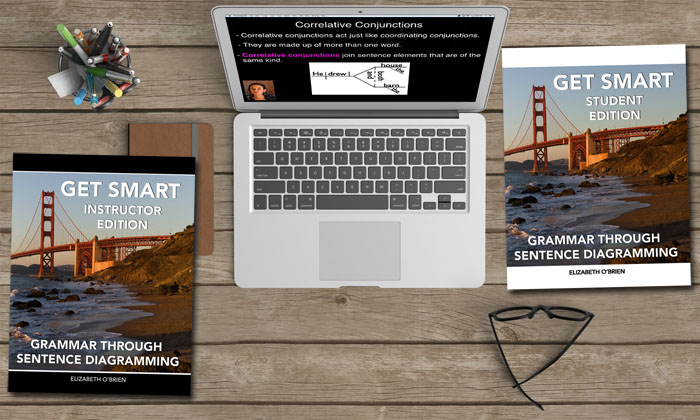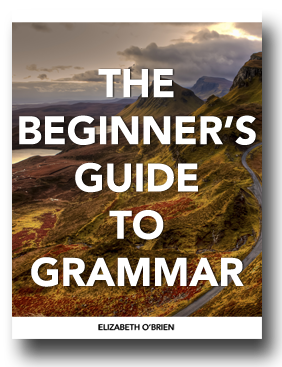LEARN GRAMMAR WITH US! WE START MONDAY, SEPTEMBER 8.
What is an appositive?
What is an appositive?
- Home
- Parts of Speech
- Nouns
- Appositives
It's time to learn what an appositive is!
Appositives are nouns that rename other nouns, and we use them to give more information about someone or something that we've already named.
In this lesson, we'll look more closely at what they are, we'll see how they're punctuated and diagrammed, and we'll go over a few other interesting things about them.
The author Victor Hugo was born in France.
Nate happily opened his gift, a new sled.
Quick Refresher
Nouns are words that name people, places, things, or ideas, and pronouns are words that take the place of nouns. Nouns and pronouns can do many jobs in our sentences (subjects, direct objects, predicate nouns, appositives…).
Adjectives are words that modify nouns or pronouns.
Appositives Rename Other Nouns
You just read that appositives are nouns that rename other nouns. They give us a little more information about the noun they're renaming. Let's look at a few examples.
The author Victor Hugo was born in France.
Author is a noun. Victor Hugo is an appositive renaming the noun author.
Esther, my sister with dark hair, sang a song.
Esther is a noun. The noun sister follows it. Sister is an appositive renaming the noun Esther.
I cooked with paprika, my favorite spice.
Paprika is a noun. The noun spice follows it. Spice is an appositive renaming the noun paprika.
We can see from those examples that an appositive is a noun that gives us extra information about another noun...and we can really see that when we diagram them!
Sentence diagrams are pictures of sentences that help show us how each word in the sentence is grammatically related. Let's see how we would diagram an appositive.

We diagram appositives directly after the noun they're renaming, and we put them in parentheses. In the example diagram above, the appositive is renaming the subject, but keep in mind that appositives can rename any noun in the sentence.

The author Victor Hugo was born in France.
Victor Hugo, an appositive, is diagrammed in parentheses directly after author, the noun it renames.*
* I used two appositives in that sentence! Can you find them?
What are appositive phrases?
The appositive plus any words that modify it come together to create an appositive phrase.
I cooked with paprika, my favorite spice.
Spice is an appositive. My favorite spice is an appositive phrase.
Esther, my sister with dark hair, sang a song.
Sister is an appositive. My sister with dark hair is an appositive phrase.
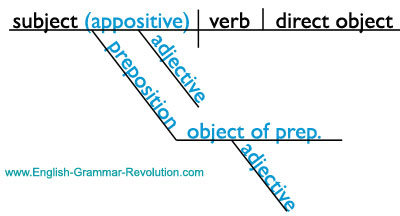
To diagram appositive phrases, put the appositive in parentheses after the noun it renames. Next, diagram any of its modifiers directly underneath it.
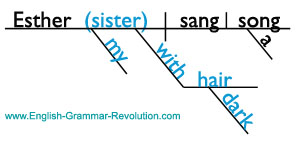
Esther, my sister with dark hair, sang a song.
When do appositives need commas?
There are two types of appositives (nonessential and essential), and it's important to know the difference because they're punctuated differently.
Nonessential/Nonrestrictive - Use Commas
Most appositives are nonessential (aka nonrestrictive). That means that they're not an essential part of the sentence, and sentences would be clear without them. You need to set these apart from the sentence with commas.
I think of these kinds of appositives as needing commas because they're merely commenting on the noun.
My sister, a French teacher, studied in France during high school.
My mom, a talented woman, recorded a lullaby CD.
My husband, David, is allergic to cats.
We can take out the appositives, and those sentences still maintain their meaning.
My sister studied in France during high school.
My mom recorded a lullaby CD.
My husband is allergic to cats.
Since we can rewrite those sentences without the appositives and the meaning of the sentences is still clear, we know that the appositives are nonessential and need commas.
Essential/Restrictive - Don't Use Commas
Some appositives are essential (aka restrictive). If they weren't in the sentence, the meaning of the sentence would be unclear.
I think of these kinds of appositives as defining so they don't use commas.
The movie Everything Everywhere All at Once won the award for best picture.
The author Victor Hugo was born in France.
Do you see how we need those in order to understand the meaning of those sentences? Without them, we wouldn't know which movie or author the sentence was referring to.
The movie won the award for best picture.
The author was born in France.
Without the appositives, these sentences don't tell us much. That means the appositives are essential and don't use commas.
Introduced With Or
Sometimes, appositives are introduced with the word or. In these cases, or is not a conjunction. We would categorize it as an expletive, a word that serves a function but doesn't have any meaning.
Rhamnus cathartica, or buckthorn, is an invasive shrub in Minnesota.
To diagram appositives introduced with or, add the or on a horizontal line above the appositive and connect it to the left of the appositive with a dotted, vertical line.

Are they always after the noun they rename?
In all of our examples above, the appositive came after the noun that it renamed, and that's usually the case. However, there is a situation where you might find the appositive before the noun it's renaming!
If an appositive is renaming the subject of a sentence, it can come before the noun it's renaming. Putting the appositive there highlights the appositive or appositive phrase.
A. Dr. Johnson, the principal of the school, set up the accounts.
Here, the subject (Dr. Johnson) comes first, and the appositive phrase (the principal of the school) comes second. That's what we're used to.
B. The principal of the school, Dr. Johnson set up the accounts.
Now the appositive phrase (the principal of the school) comes first and the subject (Dr. Johnson) comes second. Notice that this placement of the appositive helps highlight the fact that Dr. Johnson is the principal.
How Can You Tell Which Word Is The Appositive?
You might be wondering how you can tell which word is the subject and which word is the appositive.
The answer has to do with commas. Look at sentence C below. It's very similar to sentence B, but I changed one small thing, and that small change made the subject and appositive switch places. Can you figure out what I changed?
C. The principal of the school, Dr. Johnson, set up the accounts.
Did you figure it out? I added a comma after Dr. Johnson, and that change made it so that principal was the subject and Dr. Johnson was the appositive!
Intensive Pronouns
Intensive pronouns are used to emphasize another noun or pronoun. We can also call these emphatic appositives. Never use commas with these.
I made a sandwich for the president himself.
I myself paid for my popcorn.
Diagram intensive pronouns the same way that you diagram other appositives.
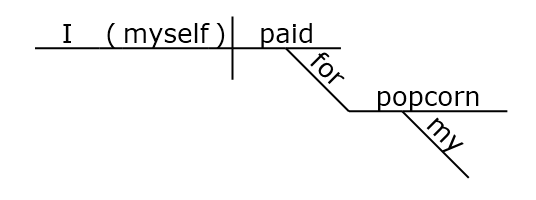
Infinitives, Gerunds, & Noun Clauses
In all of our examples so far, the appositives have been regular, old nouns that are words. But appositives can be made of any grammatical unit that functions as a noun! That means that infinitives, gerunds, and noun clauses can be appositives.
To dream the impossible dream, that is my quest.
To dream the impossible dream is an infinitive phrase. It's an appositive renaming the pronoun that. (This sentence is from Don Quixote by Cervantes.)
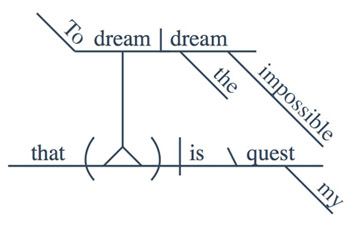
To dream the impossible dream, that is my quest.
To dream is the appositive infinitive. The second dream is the direct object of the first dream. :) The and impossible are adjectives modifying dream. The whole phrase, to dream the impossible dream, is an appositive renaming that.
The fact that she knew the answer proves that she studied.
That she knew the answer is a noun clause. It is an appositive renaming the noun fact.
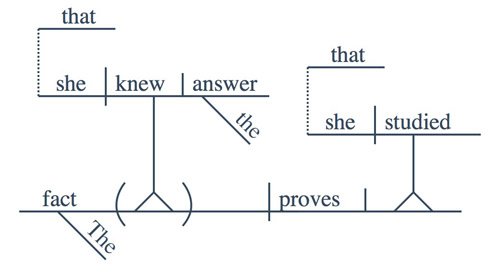
The fact that she knew the answer proves that she studied.
That she knew the answer is the appositive noun clause. That is introducing the noun clause, she is the subject, knew is the verb, answer is the direct object, and the is an adjective modifying answer.
Notice that we always diagram appositives with parentheses.
Whew! We just covered a lot of information about appositives. Be sure to sign up for our free bi-weekly newsletter and grammar guide.
Summary
Let's review what we covered in this lesson!
- Appositives are nouns or pronouns that rename other nouns or pronouns.
- Appositive phrases consist of an appositive and any word that is modifying it.
- Nonessential appositives need commas. (Commenting = Commas)
- Essential appositives don't take commas. (Defining = Don't Use Commas)
- Appositives usually come after the noun that they rename, but they can also go before the noun if they are renaming the subject.
If you'd like to teach or learn grammar the easy way—with sentence diagrams—check out our Get Smart Grammar Program.
It starts from the very beginning and teaches you grammar and sentence diagramming in easy, bite-size lessons.

Hello! I'm Elizabeth O'Brien, and my goal is to get you jazzed about grammar.
If only we had teachers like you back in the 70's when they were trying to teach me this. I was baffled by the diagramming stuff until just now. Thank you! :)
- John
This is original content from https://www.english-grammar-revolution.com/appositive.html
Our Free Guide Gives You A Fun Way
To Teach And Learn The Basics v

Elizabeth O'Brien is the creator of Grammar Revolution.
Her lessons are guaranteed to give you more confidence in your communication skills and make you smile. :)
Other Helpful Resources
Did you know that you can use these to combine sentences? See this helpful PDF to try it out!
